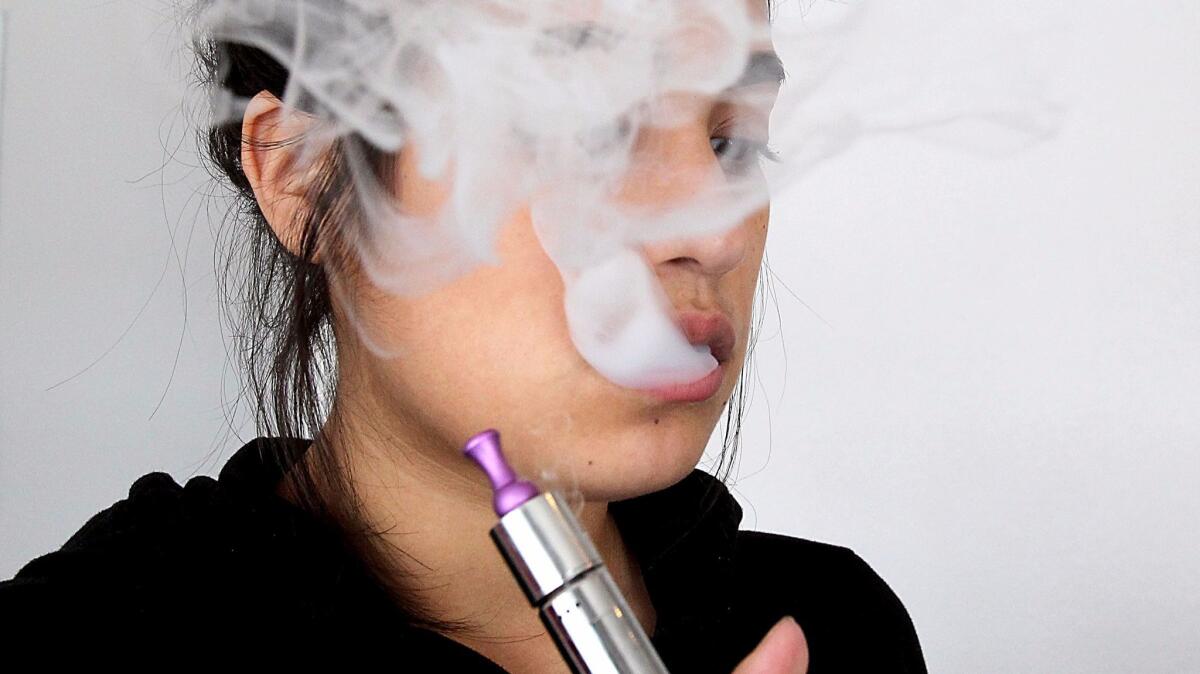E-cigarettes are a ‘major public health concern,’ especially for young people, surgeon general says

- Share via
Electronic cigarettes have all the addictive potential of traditional tobacco products, and health officials should do all they can to keep them out of the hands of teens and young adults, according to the federal government’s first comprehensive review of e-cigarettes.
The report released Thursday by the U.S. surgeon general focuses on Americans under the age of 25, the cohort that has embraced e-cigarettes with the most enthusiasm. Teens and young adults are more likely to be using the vaping devices than people in any other age group. Indeed, among middle and high school students, e-cigarettes have become more popular than traditional cigarettes.
These trends are alarming to public health officials for several reasons. Dr. Tom Frieden, director of the Centers for Disease Control and Prevention, has been warning for years that e-cigarettes have the potential to get kids hooked on nicotine, paving the way for them to “graduate” to regular smoking and setting themselves up for a lifetime of addiction. About 90% of adult smokers say they started smoking as teens.
Plus, mounting scientific evidence suggests the adolescent brain is uniquely vulnerable to the harmful effects of nicotine. Among other problems, nicotine exposure can lead to “reduced impulse control, deficits in attention and cognition, and mood disorders,” Dr. Vivek Murthy, the surgeon general, wrote in a preface to the report.
Put it all together, and “e-cigarette use among U.S. youth and young adults is now a major public health concern,” Murthy wrote.
In 2011, when the National Youth Tobacco Survey began tracking e-cigarette use, fewer than 5% of middle and high school students said they had tried the devices. By 2015, more than 1 in 10 middle schoolers and 1 in 3 high schoolers had used them at least once, according to the survey
Many of these students are vaping on a regular basis. Last year, 16% of high school students used e-cigarettes at least once in the 30 days before they took the survey, up from 1.5% in 2011. That 16% translates into 2.4 million teens. In addition, 5.3% of middle school students — or 620,000 younger adolescents — vaped at least once in the month before they were surveyed.
Among young adults 18 to 25, 55% of electronic cigarette users also smoke regular cigarettes, according to CDC data from 2013 and 2014. Although older smokers often use e-cigarettes to help them kick the habit, this is not a common practice for young adults, the report says.
Americans spent an estimated $3.5 billion on e-cigarette products last year, a 40% increase from the year before. Purveyors of e-cigarettes have lured their young customers by using the same tactics once employed by Big Tobacco, including ads highlighting themes like freedom and sex, according to the report. E-cigarettes appeal to teens and young adults because they heat liquids with flavors like mint chocolate and milk and cookies.
They also benefit from the perception that vaping is safer than smoking. That may be true, but the devices are far from harmless, the report emphasizes.
“E-cigarette aerosol is not harmless ‘water vapor,’ ” the report says. “Users of e-cigarettes risk respiratory exposure to a variety of aerosolized chemicals,” including several known to cause cancer.
The nearly 300-page report from the surgeon general doesn’t include much new data on e-cigarette use or the health risks they present. But it does include a research agenda to help fill gaps in knowledge. Among the most pressing questions: Do the chemicals in e-cigarette liquids become more dangerous when heated? To what degree are those chemicals absorbed into the bloodstream? Could changes in product design minimize the risk?
On the epidemiology front, long-term studies of teens and young adults are needed to determine whether e-cigarettes really do make people more likely to take up smoking or if they take the place of traditional cigarettes, among other questions.
Even before all the answers are in, there are things health officials can do in the name of protecting young people, the report says.
One of the biggies is to allow the U.S. Food and Drug Administration to regulate how e-cigarettes are manufactured, marketed and sold. The FDA has announced its intention to prohibit sales of e-cigarettes to minors, ban free samples of vaping products and mandate health warnings about the nicotine, among other measures. The FDA says it has this authority under the Tobacco Control Act, but the matter is currently tied up in court.
State and local governments should extend smoking bans to include electronic cigarettes, even indoors, the surgeon general argues. Meanwhile, health officials should educate pediatricians, teachers, coaches and parents so they can help teens and young adults steer clear of the devices.
“We know a great deal about what works to effectively prevent tobacco use among young people,” the report says. “Now we must apply these strategies to e-cigarettes.”
Follow me on Twitter @LATkarenkaplan and “like” Los Angeles Times Science & Health on Facebook.
MORE SCIENCE NEWS
Feathered baby dinosaur tail found trapped in amber
Scientists find antibody that hinders the spread of certain cancer cells
On average, people born in the U.S. in 2015 will live 36.5 days less than those born in 2014




